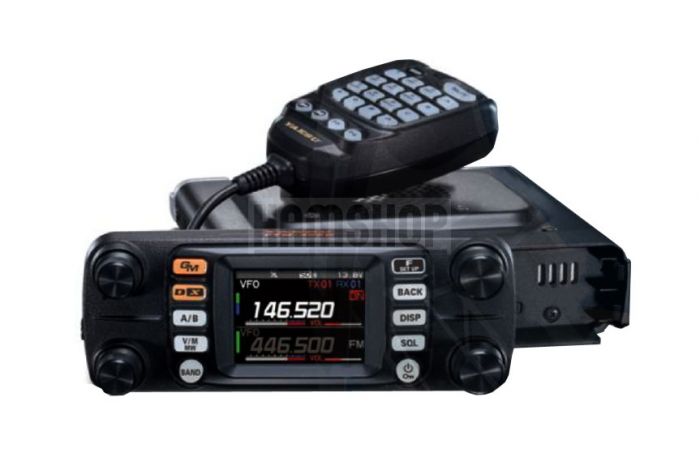
As soon as Yaesu released the FTM-300DE on the European market, I decided to get one. As I used to own an FTM-400 and was still in possession of an FT-1XDE, FT-2DE, FT3-DE, FT-70, and FTM-100DE, I was used to C4FM. And as of today, I’m still happy with C4FM…
So what about the new set? That’s a question you might expect when you buy a model that’s just hit the market. And is it for me? That last question is a bit more challenging to answer because it strongly depends on the requirements/wishes you have for a new transceiver.
After playing around with the FTM-300DE for a few days, I think the audio sounds nice. In addition, I believe that the fan does not start as quickly and is a lot quieter than the FTM-100DE or FTM-400(X)DE. The redesigned air funnel apparently does do its job.
It takes some getting used to doing without a touch screen, but once you get the hang of it, you can use it quickly, especially if you’re used to the FT-3DE two-way radio. In my opinion, everything is “hidden” in a logical place in the menu (compared to the other sets).
Since the release, Yaesu had released new firmware two days before I received the transceiver. And so the first thing I did upon receipt was initiating a firmware upgrade. The upgrade consists of two parts, a MAIN and DISP. Only for the MAIN upgrade you have to toggle a mini switch, which for convenience, is now placed in an accessible place (behind the display on the main body). The whole process takes less than fifteen minutes.
Then I tried to load memories from the FTM-100 or FTM-400 with the ADMS software. The software says you can import files, but all options were greyed out and unusable. After some testing, I imported a file from the FT-3 and wrote it to the SD card (which was pre-formatted in the transceiver). In no time, the memory channels appeared on the screen, and I was able to write the changes to the SD card and read them into the set.
The question is whether this is a good mobile set or whether it is better to use it in the shack. My idea is that if you don’t want to change too many settings on the road and remain “stuck” on a frequency or repeater, you have a great companion with the FTM-300DE. And if you do want to make a lot of adjustments while you’re behind the wheel, I recommend an FTM-400XDE. The screen of the 300, although easy to read, is still reasonably small. In addition, the fast functions are hidden behind the F key. Still, there is an extra menu layer in between, unlike, for example, with the FT-3.
Memory channel management is a different kind of thing. It is time-consuming to select the channels and assign them to a memory group unless you use the ADMS software.
Another point to note is that there is no direct jump from the last memory channel to the first memory when you turn the DIAL key to the right.
One of Yaesus’ best decisions is to implement Bluetooth by default. Though Yeasu does not allow you to use headsets with a different Pincode than 0000. So the older BH-1 and BH-2 are unusable. A big plus is that the standard PTT toggle works, so you have to press the PTT button once to start transmitting and once to stop transmitting.
In short, the FTM-300DE is a nice set, but there are plenty of areas for improvement that can quickly be addressed with a firmware update.
While using a Bluetooth headset, it might be convenient to be able to initiate memory scanning from the control panel. But since this can only be accomplished with the UP/DOWN buttons on the original handmike, Yaesu is missing the point here.
Programming can be done with an optional programming cable which is not supplied by default; the cable delivered is only for firmware upgrades. Another option to program the transceiver is by using an SD card. If you’re used to ADMS software, this version will not bring you any surprise. The software can be downloaded for free from the Yaesu site.
One word of caution with respect to running the transceiver as Wires-X node. For a couple of weeks I’ve been using the FTM-300DE as a node with the HRI-200; unlike the FTM-100DE, the 300 gets less warm. The transceiver could still be touched in a normal way, the fan has not made much noise and in that respect I am satisfied with the performance. But there is a big but…
If you start the set in Wires-X mode and start the software on your PC, you have the option to dim the display in 7 different steps. Even with the display mostly dimmed, the display lights up and the frequency set in the Wires-X remains vaguely visible in the background. With the active VFO you don’t have such a problem because the display of the frequency is bright enough, but with the inactive VFO you can vaguely see the frequency used in the Wires-X software.
So you cannot completely switch off the display. So be careful with this!